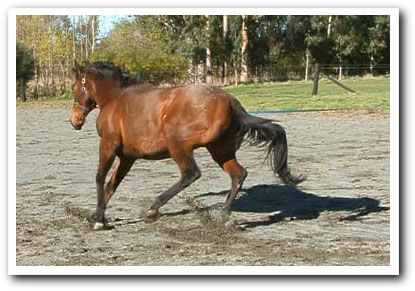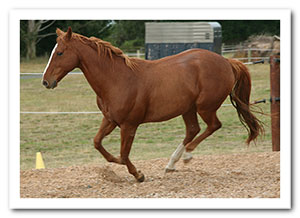Sacro-iliac & Saddle Fit Problems
These are so common and more often than not are NOT the result of an injury.
They can easily be just another manifestation of a serious mineral imbalance, that of excess potassium relative to sodium, chloride, calcium and magnesium!
Often goes along with the other symptoms of being touchy, not wanting to be groomed, saddled etc.
The horse trying to canter on the right, was suspected of having a fractured pelvis, when in actual fact it was all a grass problem. Once her diet was corrected she went on to compete again - see Milly's Story.
How ‘Sacro-iliac’ issues can be caused by Mineral Imbalances
This video is a classic example of what a seriously Grass Affected horse looks like on the lunge. It was very good of Louise to allow us to share and she did a great job of following instructions and changing the horse’s diet to our feeding regime. (Swapping Lucerne hay for grassy hay was pivotal) Believe it or not, the horse was able to go back to trail riding, pony club events and beach riding.
You can read her experience here
When something is wrong with your horse and you call the vet, chiropractor or physio they will be looking for one or more locations on or within the horse’s body where there is some kind of change or ‘injury’ to tissues. If they find one then they know what to do and can ‘treat’ it appropriately.
However there are multiple issues exhibited by grass-affected horses where no-one will be able to find any LESIONS because there aren’t any – even on autopsy. This is because the ‘injury’ is to the horse’s homeostatic mechanisms - his ability to balance his own minerals. Frequently identified are areas of inflammation and ‘soreness’ and difficulty performing simple tasks like being lunged.
Many people go to enormous expense investigating, for example having the pelvic area x-rayed only to find there is absolutely nothing physically wrong.
This is especially true when it comes to sacro-iliac problems; which Libby is showing clearly in the video clip – so how on earth could these be caused by mineral imbalances?
When the horse is bunny hopping or disuniting at the canter, unable to track up, difficult to maintain on the correct bend and tail swishing - what is going on?
The largest muscle masses are located in the hind-quarters with major nerves along the spine operating them. It takes EXACTLY the right quantities and ratios of certain minerals, namely sodium, potassium, calcium and magnesium, for the nerves and muscles to be able to function properly, enabling normal movement and behaviour.
Other signs include hitching a leg, ‘knuckling over’ and/or tripping over nothing as you ride.
If there is no evidence of physical injury it is very likely to be a mineral imbalance which indicates the diet needs adjusting.
In our experience this entails lowering potassium intake and adding salt.
Providing our diet recommendations are followed carefully, you will see vast improvements within a month. See Diet Recommendations
Take a look at our FACEBOOK page and Scroll back to ‘Aspects of Pasture that can Adversely Affect Your Horse’ (posted on September 8th ) to see what we mean.

Overview
Put your horse on the lunge. At the walk they may appear normal.
The trot may be normal or they may appear stiff or tight behind, not tracking up.
Where it really shows up is at the canter especially the first few strides where you will see the back legs together, swapping leads behind. If it isn’t too bad they warm out of it but in worse cases they have great difficulty cantering a circle, lunging and kicking out, charging off often with the head thrown up and a climbing action with the front legs.
These problems are featuring frequently on various help and advice forums. Most people jump to the conclusion that these are physical issues, without considering the possibility they may actually be physiological or bio-chemistry problems. It becomes obvious when you do some reading and start understanding the physiology of nerve impulse transmission and muscle function.
Horses are large animals comprising about 80% muscle with the largest of these located in the back and hind-quarters, in particular the sacro-iliac/pelvic areas. There is no way that bones go ‘out’ in the vertebral column or the pelvic area as they are completely locked in there by these very strong muscles and ligaments.
A horse falling over can certainly cause physical injury, by tearing the Velcro-like ligaments that hold the sacro-iliac joint on to the pelvis. This is an injury to be avoided. It most commonly occurs when horses are honing around on slippery ground. Sometimes a green unbalanced horse’s legs will slide out from underneath him.
The Symptoms...

However horses that are stiff, tight behind, bunny-hopping, cross-firing, kicking out, short-stepping, uncomfortable or difficult to ride, hollowing out, hitching a leg will respond very well to addressing the whole diet as all these can be caused by a disturbance to the bio chemistry which operates the nerves and muscles. All of the above can be seen when the horse is lunged
Millie’s story is a classic example where thousands of dollars were spent on expensive x-rays which showed up nothing because it was not a physical problem but a diet related problem…
Read how a Suspected Fractured Pelvis Turned Out to be a Grass Issue.
This story includes video clips of what we are talking about here.
Before & After
If possible have someone video the horse Before you make the Recommended Diet Changes.
Once again you would swear this is some kind of physical problem but you will be amazed at how many times it is just the grass causing it.
How can you tell?
Take the horse off the grass temporarily and take the Recommended Steps. Believe me this will save you a lot of money, time effort and stress.
Lunge the horse every few days to monitor progress.
It should only take a few weeks for the horse to be back to all three gaits being normal with smooth transitions in between.
Saddle Fit
Of course everybody should ensure their saddle is comfortable for their horse. However, if your horse has sore, inflamed muscles then no saddle in the world is going to ‘fit’ or be remotely comfortable for the horse.
I have met people who have had multiple saddle-fitting sessions, even had a saddle made to a mould of the horse’s back, and still it doesn’t fit.
In these cases it is not the saddle that is the problem.
We have found time after time that these issues just go away with the Recommended Diet Changes as in the story of how Rye-Grass Ruined Red.
This is a logical place to start as it is so simple and most of the time it is all you need. The diet changes can by all means be done in conjunction with your other chosen modalities and will significantly improve their effectiveness.
 Calm Healthy Horses
Calm Healthy Horses